
List of rulers of Bohemia
Encyclopedia
This is a list of rulers of Bohemia who ruled the country first as dukes and later as kings from the 9th century until 1918. Bohemia
, from the 14th century the Lands of the Bohemian Crown
, became part of the Republic of Czechoslovakia
in 1918 and since 1993 is known as the Czech Republic
.
Princes of Great Moravia
Bohemia
Bohemia is a historical region in central Europe, occupying the western two-thirds of the traditional Czech Lands. It is located in the contemporary Czech Republic with its capital in Prague...
, from the 14th century the Lands of the Bohemian Crown
Lands of the Bohemian Crown
The Lands of the Bohemian Crown , also called the Lands of the Crown of Saint Wenceslas or simply the Bohemian Crown or Czech Crown lands , refers to the area connected by feudal relations under the joint rule of the Bohemian kings...
, became part of the Republic of Czechoslovakia
Czechoslovakia
Czechoslovakia or Czecho-Slovakia was a sovereign state in Central Europe which existed from October 1918, when it declared its independence from the Austro-Hungarian Empire, until 1992...
in 1918 and since 1993 is known as the Czech Republic
Czech Republic
The Czech Republic is a landlocked country in Central Europe. The country is bordered by Poland to the northeast, Slovakia to the east, Austria to the south, and Germany to the west and northwest....
.
Princes of Great MoraviaGreat MoraviaGreat Moravia was a Slavic state that existed in Central Europe and lasted for nearly seventy years in the 9th century whose creators were the ancestors of the Czechs and Slovaks. It was a vassal state of the Germanic Frankish kingdom and paid an annual tribute to it. There is some controversy as...
- Mojmír IMojmír IMojmir I or Moimir I was the first known ruler of the Moravian Slavs . In modern scholarship, the creation of the early medieval state known as "Great" Moravia is attributed either to his or to his successors' expansionist policy...
(833-846) - RastislavRastislavRastislav or Rostislav was the second known ruler of Moravia . Although he started his reign as vassal to Louis the German, king of East Francia, he consolidated his rule to the extent that after 855 he was able to repel a series of Frankish attacks...
(846-870) - SlavomírSlavomírSlavomír or Sclagamar was a duke of Moravia . He led a revolt against the Franks who had annexed Moravia during the incarceration of his relative, Svatopluk I.- Early life :...
(871) (interim) - Svatopluk ISvatopluk ISvatopluk I or Zwentibald I was the greatest ruler of Moravia that attained its maximum territorial expansion in his reign . His career had already started in the 860s, when he governed a principality, the location of which is still a matter of debate among historians, within Moravia under the...
(871-894) - Mojmír IIMojmír IIMojmir II was the last king of the Great Moravian Empire . Because of a civil war with his brother, he failed to prevent dismemberment of his Empire and probably died while fighting Magyar invaders....
(894-906?)
Legendary rulers of Bohemia
- Praotec Čech (Pater Boemus)
- Krok
- LibušeLibušeLibuše, Libussa or, historically Lubossa, is a legendary ancestor of the Přemyslid dynasty and the Czech people as whole. Libuše was the wisest of the three sisters and prophesied the foundation of Prague from her castle Libušín...
, duchess; Přemysl, the PloughmanPremysl, the PloughmanThe Czechs name Přemysl, the Ploughman, as the mythical ancestor of the Přemyslid dynasty, containing the line of princes and kings which ruled in the Lands of the Bohemian Crown from 873 or earlier until the murder of Wenceslaus III in 1306.-Story:According to a legend, Přemysl was a peasant of...
, her husband. - NezamyslNezamyslNezamysl was the first of the seven Bohemian mythical princes between the founder of the Přemyslid dynasty Přemysl the Ploughman and the first historical prince Bořivoj...
- MnataMnataMnata was the second of the seven Bohemian mythical princes between the founder of the Přemyslid dynasty Přemysl, the Ploughman and the first historical prince Bořivoj...
- VojenVojenVojen was the third of the seven Bohemian mythical princes between the founder of the Přemyslid dynasty Přemysl the Ploughman and the first historical prince Bořivoj...
- VnislavVnislavVnislav was the fourth of the seven Bohemian mythical princes between the founder of the Přemyslid dynasty Přemysl the Ploughman and the first historical prince Bořivoj...
- KřesomyslKresomyslKřesomysl was the fifth of the seven Bohemian mythical princes between the founder of the Přemyslid dynasty Přemysl the Ploughman and the first historical prince Bořivoj...
- NeklanNeklanNeklan was the sixth of the seven Bohemian mythical princes between the founder of the Přemyslid dynasty Přemysl the Ploughman and the first historical prince Bořivoj...
- HostivítHostivítHostivít was the last of the seven Bohemian mythical princes between the founder of the Přemyslid dynasty Přemysl the Ploughman and the first historical prince Bořivoj...
Dukes
| Dukes of Bohemia | |||
| Přemyslid dynasty Premyslid dynasty The Přemyslids , were a Czech royal dynasty which reigned in Bohemia and Moravia , and partly also in Hungary, Silesia, Austria and Poland.-Legendary rulers:... | |||
| Image | Name | Date | Notes |
| Bořivoj I Borivoj I of Bohemia Bořivoj I was the first historically documented Duke of Bohemia and founder of Přemyslid dynasty.As the head of the Přemyslids who dominated the environs of present-day Prague, around 870 Bořivoj declared himself kníže - in latin dux, which means sovereign prince... | c.870–888/9 | ||
| Spytihněv I Spytihnev I of Bohemia Spytihněv I was Duke of Bohemia from 894/895 until his death.He was the eldest son of Duke Bořivoj I, the first historically confirmed Bohemian ruler of the Přemyslid dynasty, and his wife Ludmila. As he was still a minor upon his father's death in 899, the Bohemian lands were under the regency of... | 894–915 | Son of Bořivoj I. | |
 | Vratislaus I Vratislaus I of Bohemia Vratislaus I , a scion of the Přemyslid dynasty, was Duke of Bohemia from 915 to 921.He was the son of Duke Borivoj I of Bohemia by his wife Ludmila, and the younger brother of Duke Spytihnev I.... (Vratislav) | 915–921 | Brother of Spytihněv I. |
 | Wenceslaus I Wenceslaus I, Duke of Bohemia Wenceslaus I , or Wenceslas I, was the duke of Bohemia from 921 until his assassination in 935, purportedly in a plot by his own brother, Boleslav the Cruel.... (Václav) | 921–935 | Son of Vratislaus I; known as St. Wenceslaus ("Good King Wenceslas" for English speaking people), the patron saint Patron saint A patron saint is a saint who is regarded as the intercessor and advocate in heaven of a nation, place, craft, activity, class, clan, family, or person... of the Czech lands Czech lands Czech lands is an auxiliary term used mainly to describe the combination of Bohemia, Moravia and Czech Silesia. Today, those three historic provinces compose the Czech Republic. The Czech lands had been settled by the Celts , then later by various Germanic tribes until the beginning of 7th... . |
 | Boleslaus I the Cruel Boleslaus I of Bohemia Boleslaus I the Cruel, also called Boleslav I , was the ruler of Bohemia from 935 to his death. His was the son of Vratislaus I and the younger brother of his predecessor, Saint Wenceslaus.Boleslav is notorious for the murder of his brother Wenceslaus, through which he became duke of Bohemia... (Boleslav I. Ukrutný) | 935–972 | Brother of Wenceslaus I. |
 | Boleslaus II the Pious Boleslaus II of Bohemia Boleslaus II the Pious was the duke of Bohemia from 972, a member of the Přemyslid dynasty.The son of Boleslaw also called Boleslaus I and Biagota, Boleslaus II became Duke in on his father's death. Boleslaus maintained good relations with the Ottonian German kings, and in 975 supported Otto II... (Boleslav II. Pobožný) | 972–999 | Son of Boleslaus I. |
| Boleslaus III the Redhead Boleslaus III of Bohemia Boleslaus III , called the Red or the Blind, was the duke of Bohemia from 999 until 1002 AD. He was the "worst of all men who ever sat on the Bohemian throne."... (Boleslav III. Ryšavý) | 999–1002 | Son of Boleslaus II. | |
| Vladivoj Vladivoj of Bohemia Vladivoj was duke of Bohemia from 1002 to his death.The origins of the Czech duke Vladivoj are unclear. He was probably a Přemyslid, or a distant relative. He began to reign in 1002, when the former Czech duke Boleslav III unwillingly ended his own reign. It is said that Vladivoj was an alcoholic,... | 1002–1003 | Of the Piast dynasty Piast dynasty The Piast dynasty was the first historical ruling dynasty of Poland. It began with the semi-legendary Piast Kołodziej . The first historical ruler was Duke Mieszko I . The Piasts' royal rule in Poland ended in 1370 with the death of king Casimir the Great... (?). Said to be first cousin of Boleslav III. Polish name Władywoj. | |
| Boleslaus III | 1003 | Second time. | |
 | Boleslaus the Brave (Boleslav Chrabrý) | 1003–1004 | Of the Piast dynasty Piast dynasty The Piast dynasty was the first historical ruling dynasty of Poland. It began with the semi-legendary Piast Kołodziej . The first historical ruler was Duke Mieszko I . The Piasts' royal rule in Poland ended in 1370 with the death of king Casimir the Great... ; brother of Vladivoj (?), grandson of Boleslaus I. Duke and later king of Poland. |
| Jaromír Jaromir of Bohemia Jaromir was the second son of Boleslaus II the Pious and Emma. In 1003, he rebelled against his elder brother Boleslaus III, who had him emasculated, but was unable to secure the throne which was subsequently taken by Boleslaw the Brave, King of Poland. Jaromir and his brother Oldrich then sought... | 1004–1012 | Brother of Boleslaus III. | |
| Ulrich (Oldřich) | 1012–1033 | Brother of Jaromír. Also known as Odalrich and Udalrich. | |
| Jaromír | 1033–1034 | Second time. | |
| Ulrich | 1034 | Second time. | |
| Bretislaus I Bretislaus I of Bohemia Bretislaus I , known as Bohemian Achilles, of the house of the Přemyslids, was the duke of Bohemia from 1035 till death.-Youth:... (Břetislav I.) | 1034–1055 | Son of Ulrich. | |
 | Spytihněv II Spytihnev II of Bohemia Spytihnev II was the duke of Bohemia from March 1055 until his death in 1061. He was the eldest son of Bretislaus I. His coronation was celebrated with the first known rendition of Lord, Have Mercy on Us. After succeeding to the throne, he went at once to Regensburg to receive imperial confirmation... | 1055–1061 | Son of Bretislaus I. |
 | Vratislaus II Vratislaus II of Bohemia -Literature:*Vratislav Vaníček: Vratislav II. . První český král. Vyšehrad 2004, ISBN 80-7021-655-7*Hans Patze: Die Pegauer Annalen, die Königserhebung Wratislaws v. Böhmen und die Anfänge der Stadt Pegau. JGMODtl 12, 1963, 1-62... (Vratislav II.) | 1061–1092 | Brother of Spytihněv II. King 1085–1092 as Vratislaus I. |
 | Conrad I Conrad I of Bohemia Conrad I of Brno was the duke of Bohemia for eight months in 1092. He was the brother and successor of Vratislaus II . He was the third son of Bretislaus I and Judith of Schweinfurt... (Konrád I. Brněnský) | 1092 | Brother of Vratislavus II. |
| Bretislaus II Bretislaus II of Bohemia Bretislaus II was the duke of Bohemia from 14 September 1092 until his death. He was the eldest son of King Vratislaus II and Adelaide, daughter of Andrew I of Hungary. He was a major enemy of paganism.... (Břetislav II.) | 1092–1100 | Nephew of Conrad I, son of Vratislav II. | |
| Bořivoj II Borivoj II of Bohemia Borivoj II was the duke of Bohemia from 25 December 1100 until May 1107 and from December 1117 until 16 August 1120. He was the younger half-brother and successor of Bretislaus II.... | 1101–1107 | Brother of Bretislaus II. | |
| Svatopluk Svatopluk of Bohemia Svatopluk the Lion was the duke of Bohemia from 1107 to his assassination. He was a son of Otto I of Olomouc and Euphemia of Hungary and grandson of Bretislaus I of Bohemia.... (Sventopluk Olomoucký) | 1107–1109 | First cousin of Bořivoj II. | |
 | Vladislaus I Vladislaus I of Bohemia Vladislaus I , duke of Bohemia from 1109 to 1117 and from 1120 to April 12, 1125.Vladislav I was a son of Duke, later King, Vratislav II of Bohemia by his second wife Swatawa, a daughter of Casimir I of Poland. Together with his cousin Svatopluk, Vladislav expelled his brother Bořivoj II from... (Vladislaus) | 1109–1117 | Brother of Bořivoj II. |
| Bořivoj II | 1117–1120 | Second time | |
 | Vladislaus I | 1120–1125 | Second time |
| Sobeslaus I Sobeslav I of Bohemia Sobeslaus I was Duke of Bohemia from 1125 until his death. He was a member of the Přemyslid dynasty, the youngest son of Vratislaus II , the first Bohemian duke to also rule as king, with his third wife Svatava of Poland.-Life:... (Soběslav I.) | 1125–1140 | Brother of Vladislaus I. | |
| Vladislaus II (Vladislav II.) | 1140–1172 | Nephew of Sobeslaus I, son of Duke Vladislaus I. King 1158–1172 as Vladislaus I. | |
 | Frederick Frederick of Bohemia Frederick was the duke of Olomouc from 1164 and then duke of Bohemia from 1172 to 1173 and again from 1178 to his death. He was the son of King Vladislaus II, who abdicated in 1172 in his favour... (Bedřich) | 1172–1173 | Son of Vladislaus II. |
| Sobeslaus II Sobeslav II of Bohemia Sobeslav II, called Prince of the Peasants or King of the Peasants, was the duke of Bohemia from 1173 to 1179. He was the second son of Sobeslav I. Supported by neither noblesse nor emperor, he was backed solely by the lowest classes.... (Soběslav II.) | 1173–1178 | First cousin once removed of Frederick, Son of Sobeslaus I. | |
 | Frederick | 1178–1189 | Second time. |
 | Conrad II Otto Conrad II of Bohemia Conrad II Otto was a member of Přemyslid dynasty, son of Duke Conrad II of Znojmo. He was the duke of Znojmo from 1177 until he was made margrave of Moravia from 1182 to 1186. He was then duke of Bohemia from 1189 to his death... (Konrád II. Ota) | 1189–1191 | Descendant of Conrad I. |
| Wenceslaus II Wenceslaus II, Duke of Bohemia Wenceslaus II was the son of Sobeslav I and brother of Sobeslav II. He was the duke of Bohemia following Conrad II in 1191.He was the duke of Olomouc and Brno, but was deposed by Duke Frederick in 1179 and exiled. He returned from exile after thirteen years on Conrad's death.Wenceslaus was... (Václav II.) | 1191–1192 | Brother of Sobeslaus II. | |
 | Ottokar I Ottokar I of Bohemia -External links:... (Přemysl I. Otakar) | 1192–1193 | Son of Vladislaus II. |
| Henry Bretislaus Bretislaus III of Bohemia Henry Bretislaus III was the duke of Bohemia from 1193 to his death. Being the bishop of Prague since 1182, he was also a prince of the Holy Roman Empire. He was a son of Henry, son of Vladislaus I.... (Jindřich Břetislav) | 1193–1197 | First cousin of Ottokar I. | |
 | Vladislaus Henry Vladislaus III of Bohemia Vladislaus III Henry was the youngest son of Vladislaus II and younger brother of Ottokar I. On June 22, 1197, he was elected Duke of Bohemia. Faced with an uprising in favour of Ottokar, Vladislaus abdicated a few months later on December 6... (Vladislav Jindřich) | 1197 | Brother of Ottokar I. |
 | Ottokar I | 1197–1198 | Second time. Became king in 1198, and his descendants retained the title. |
Kings
| Kings of Bohemia | |||
| Přemyslid dynasty Premyslid dynasty The Přemyslids , were a Czech royal dynasty which reigned in Bohemia and Moravia , and partly also in Hungary, Silesia, Austria and Poland.-Legendary rulers:... | |||
| Image | Name | Date | Notes |
 | Ottokar I Ottokar I of Bohemia -External links:... (Přemysl I. Otakar) | 1198–1230 | Hereditary royal title approved by King Philip of Germany Philip of Swabia Philip of Swabia was king of Germany and duke of Swabia, the rival of the emperor Otto IV.-Biography:Philip was the fifth and youngest son of Emperor Frederick I and Beatrice I, Countess of Burgundy, daughter of Renaud III, count of Burgundy, and brother of the emperor Henry VI... , confirmed by the 1212 Golden Bull of Sicily Golden Bull of Sicily The so-called Golden Bull of Sicily was a decree issued by King Frederick II of Germany in Basel on 26 September 1212 that confirmed the royal title obtained by Ottokar I of Bohemia in 1198, declaring him and his heirs Kings of Bohemia... |
 | Wenceslaus I (Václav I.) | 1230–1253 | Son of Ottokar I. |
 | Ottokar II (Otakar II.) | 1253–1278 | Son of Wenceslaus I. Also Duke of Austria Austria Austria , officially the Republic of Austria , is a landlocked country of roughly 8.4 million people in Central Europe. It is bordered by the Czech Republic and Germany to the north, Slovakia and Hungary to the east, Slovenia and Italy to the south, and Switzerland and Liechtenstein to the... , Duke of Styria Duchy of Styria The history of Styria concerns the region roughly corresponding to the modern Austrian state of Styria and the Slovene region of Styria from its settlement by Germans and Slavs in the Dark Ages until the present... , Duke of Carinthia Duchy of Carinthia The Duchy of Carinthia was a duchy located in southern Austria and parts of northern Slovenia. It was separated from the Duchy of Bavaria in 976, then the first newly created Imperial State beside the original German stem duchies.... and Duke of Carniola Carniola Carniola was a historical region that comprised parts of what is now Slovenia. As part of Austria-Hungary, the region was a crown land officially known as the Duchy of Carniola until 1918. In 1849, the region was subdivided into Upper Carniola, Lower Carniola, and Inner Carniola... . |
 | Wenceslaus II (Václav II.) | 1278–1305 | Son of Ottokar II. Also Duke of Kraków (from 1291) and King of Poland Poland Poland , officially the Republic of Poland , is a country in Central Europe bordered by Germany to the west; the Czech Republic and Slovakia to the south; Ukraine, Belarus and Lithuania to the east; and the Baltic Sea and Kaliningrad Oblast, a Russian exclave, to the north... (1300–1305). |
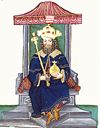 | Wenceslaus III Wenceslaus III of Bohemia Wenceslaus III Premyslid was the King of Hungary , King of Bohemia and the king of Poland .... (Václav III.) | 1305–1306 | Son of Wenceslaus II. Uncrowned (as Bohemian king). Also King of Hungary Hungary Hungary , officially the Republic of Hungary , is a landlocked country in Central Europe. It is situated in the Carpathian Basin and is bordered by Slovakia to the north, Ukraine and Romania to the east, Serbia and Croatia to the south, Slovenia to the southwest and Austria to the west. The... and King of Poland. |
| Non-dynastic | |||
 | Henry the Carinthian Henry I of Bohemia Henry VI of Carinthia from the House of Meinhardin was King of Bohemia in 1306 and again from 1307 until 1310 as well as Count of Tyrol and Duke of Carinthia and Carniola from 1295 until his death.-Life:... (Jindřich Korutanský) | 1306 | Meinhardiner. Son-in-law of Wenceslaus II. Non-crowned. |
 | Rudolph I Rudolph I of Bohemia Rudolf I of Habsburg was Duke of Austria and Styria from 1298 and King of Bohemia and titular King of Poland from 1306 until his death... (Rudolf I.) | 1306–1307 | Habsburg Habsburg The House of Habsburg , also found as Hapsburg, and also known as House of Austria is one of the most important royal houses of Europe and is best known for being an origin of all of the formally elected Holy Roman Emperors between 1438 and 1740, as well as rulers of the Austrian Empire and... . Second husband of Elisabeth Richeza of Poland Elisabeth Richeza of Poland Elisabeth Richenza of Poland was a daughter and the only surviving child of Przemysl II of Poland and his second wife Richenza of Sweden, herself a daughter of Valdemar I of Sweden and Sofia of Denmark.Her name at birth was Richeza; she adopted the name Elisabeth after her first marriage... , widow of Wenceslaus II. Non-crowned. |
 | Henry the Carinthian | 1307–1310 | Second time |
| Luxembourg dynasty | |||
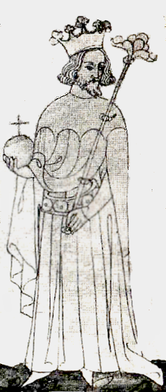 | John the Blind (Jan Lucemburský) | 1310–1346 | Son-in-law of Wenceslaus II. |
| Charles I Charles IV, Holy Roman Emperor Charles IV , born Wenceslaus , was the second king of Bohemia from the House of Luxembourg, and the first king of Bohemia to also become Holy Roman Emperor.... (Karel I.) | 1346–1378 | Son John. Also Holy Roman Emperor Holy Roman Emperor The Holy Roman Emperor is a term used by historians to denote a medieval ruler who, as German King, had also received the title of "Emperor of the Romans" from the Pope... as Charles IV and generally known as such. | |
| Wenceslaus IV (Václav IV.) | 1378–1419 | Son of Charles IV. Also King of the Romans King of the Romans King of the Romans was the title used by the ruler of the Holy Roman Empire following his election to the office by the princes of the Kingdom of Germany... until 1400. | |
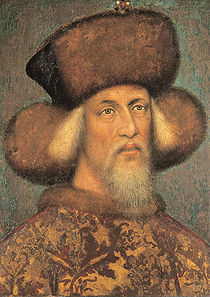 | Sigismund Sigismund, Holy Roman Emperor Sigismund of Luxemburg KG was King of Hungary, of Croatia from 1387 to 1437, of Bohemia from 1419, and Holy Roman Emperor for four years from 1433 until 1437, the last Emperor of the House of Luxemburg. He was also King of Italy from 1431, and of Germany from 1411... (Zikmund) | 1419–1437 | Brother of Wenceslaus IV. Ruled effective 1436–1437 only (because of the Hussite Revolution). Also Holy Roman Emperor and King of Hungary. |
| Habsburg dynasty | |||
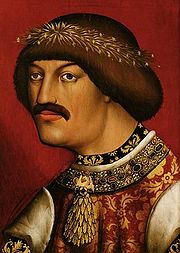 | Albert (Albrecht Habsburský) | 1437–1439 | Son-in-law of Sigismund. Also King of the Romans and of Hungary. |
| interregnum Interregnum An interregnum is a period of discontinuity or "gap" in a government, organization, or social order... | 1440–1453 | The succession of Albert's son was not recognized by the Czech nobility for the most of this era; the land was administered by the landfriedens (provincial & territorial). | |
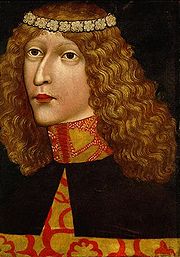 | Ladislaus the Posthumous Ladislas the Posthumous Ladislaus the Posthumous was Duke of Austria from 1440, King of Hungary from 1444 and King of Bohemia from 1453.- Biography :... (Ladislav Pohrobek) | 1453–1457 | Son of Albert born after his father's death. Also King of Hungary. |
| Non-dynastic | |||
 | George of Podebrady George of Podebrady George of Kunštát and Poděbrady , also known as Poděbrad or Podiebrad , was King of Bohemia... (Jiří z Poděbrad) | 1457–1471 | Elected king from the Czech noble family House of Kunštát. Although he had descendants, the succession devolved to the prince from Polish kingdom. |
 | Matthias I Corvinus (Matyáš Korvín) | 1469–1490 | King of Hungary, elected by the insurgent Catholic Czech aristocrats as antiking Antiking An Antiking is a would-be king who, due to succession disputes or simple political opposition, declares himself king in opposition to a reigning monarch. Antikings are more often found in elected monarchies than in hereditary monarchies like those of England and France; such figures in hereditary... in 1469, but never crowned. In 1479, he agreed to limit his rule to Moravia Moravia Moravia is a historical region in Central Europe in the east of the Czech Republic, and one of the former Czech lands, together with Bohemia and Silesia. It takes its name from the Morava River which rises in the northwest of the region... , Silesia Silesia Silesia is a historical region of Central Europe located mostly in Poland, with smaller parts also in the Czech Republic, and Germany.Silesia is rich in mineral and natural resources, and includes several important industrial areas. Silesia's largest city and historical capital is Wrocław... , and Lusatia Lusatia Lusatia is a historical region in Central Europe. It stretches from the Bóbr and Kwisa rivers in the east to the Elbe valley in the west, today located within the German states of Saxony and Brandenburg as well as in the Lower Silesian and Lubusz voivodeships of western Poland... , while retaining his title. |
| Jagiellonian dynasty | |||
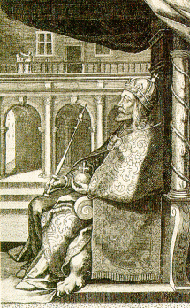 | Vladislaus II the Jagiellonian Vladislaus II of Bohemia and Hungary Vladislaus II, also known as Ladislaus Jagiellon ; was King of Bohemia from 1471 and King of Hungary from 1490 until his death in 1516... (Vladislav II. Jagellonský) | 1471–1516 | Nephew of Ladislaus the Posthumous; elected on request of his predecessor George. Also King of Hungary after 1490. |
| Louis the Jagiellonian (Ludvík Jagellonský) | 1516–1526 | Son of Vladislaus II. Also King of Hungary. | |
| Habsburg dynasty | |||
 | Ferdinand I Ferdinand I, Holy Roman Emperor Ferdinand I was Holy Roman Emperor from 1558 and king of Bohemia and Hungary from 1526 until his death. Before his accession, he ruled the Austrian hereditary lands of the Habsburgs in the name of his elder brother, Charles V, Holy Roman Emperor.The key events during his reign were the contest... | 1526–1564 | Brother-in-law of Louis; elected king. Also King of Hungary and Holy Roman Emperor-elect from 1558. |
 | Maximilian Maximilian II, Holy Roman Emperor Maximilian II was king of Bohemia and king of the Romans from 1562, king of Hungary and Croatia from 1563, emperor of the Holy Roman Empire of the German Nation from 1564 until his death... (Maximilián) | 1564–1576 | Son of Ferdinand I, grandson of Vladislaus II. Also King of Hungary and Holy Roman Emperor. |
| Rudolph II Rudolf II, Holy Roman Emperor Rudolf II was Holy Roman Emperor , King of Hungary and Croatia , King of Bohemia and Archduke of Austria... (Rudolf II.) | 1576–1611 | Son of Maximilian I. Also King of Hungary and Holy Roman Emperor. | |
 | Matthias (Matyáš) | 1611–1619 | Brother of Rudolph II. Also King of Hungary and Holy Roman Emperor. |
 | Ferdinand II Ferdinand II, Holy Roman Emperor Ferdinand II , a member of the House of Habsburg, was Holy Roman Emperor , King of Bohemia , and King of Hungary . His rule coincided with the Thirty Years' War.- Life :... | 1619–1637 | Nephew of Matthias. Also King of Hungary and Holy Roman Emperor. |
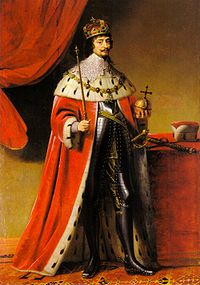 | Frederick Frederick V, Elector Palatine Frederick V was Elector Palatine , and, as Frederick I , King of Bohemia .... | 1619–1620 | Member of the House of Wittelsbach. Antiking Antiking An Antiking is a would-be king who, due to succession disputes or simple political opposition, declares himself king in opposition to a reigning monarch. Antikings are more often found in elected monarchies than in hereditary monarchies like those of England and France; such figures in hereditary... , elected by the Crown's Estates at the beginning of the Thirty Years' War but after the lost Battle of White Mountain Battle of White Mountain The Battle of White Mountain, 8 November 1620 was an early battle in the Thirty Years' War in which an army of 30,000 Bohemians and mercenaries under Christian of Anhalt were routed by 27,000 men of the combined armies of Ferdinand II, Holy Roman Emperor under Charles Bonaventure de Longueval,... he fled the country. |
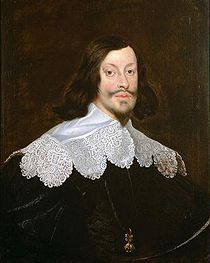 | Ferdinand III Ferdinand III, Holy Roman Emperor Ferdinand III was Holy Roman Emperor from 15 February 1637 until his death, as well as King of Hungary and Croatia, King of Bohemia and Archduke of Austria.-Life:... | 1627–1657 | Son of Ferdinand II. Also King of Hungary and Holy Roman Emperor. |
 | Ferdinand IV | 1646–1654 | Son of Ferdinand III. Junior co-monarch during his father's reign. Also King of Hungary and King of the Romans. |
 | Leopold I Leopold I, Holy Roman Emperor | style="float:right;" | Leopold I was a Holy Roman Emperor, King of Hungary and King of Bohemia. A member of the Habsburg family, he was the second son of Emperor Ferdinand III and his first wife, Maria Anna of Spain. His maternal grandparents were Philip III of Spain and Margaret of Austria... | 1657–1705 | Brother of Ferdinand IV. Also King of Hungary and Holy Roman Emperor. |
| Joseph I Joseph I, Holy Roman Emperor Joseph I , Holy Roman Emperor, King of Bohemia, King of Hungary, King of the Romans was the elder son of Emperor Leopold I and his third wife, Eleonor Magdalene of Neuburg.... (Josef I.) | 1705–1711 | Son of Leopold I. Also King of Hungary and Holy Roman Emperor. | |
 | Charles II Charles VI, Holy Roman Emperor Charles VI was the penultimate Habsburg sovereign of the Habsburg Empire. He succeeded his elder brother, Joseph I, as Holy Roman Emperor, King of Bohemia , Hungary and Croatia , Archduke of Austria, etc., in 1711... (Karel II.) | 1711–1740 | Brother of Joseph I. Also King of Hungary and Holy Roman Emperor as Charles VI. |
| Charles Albert Charles VII, Holy Roman Emperor Charles VII Albert a member of the Wittelsbach family, was Prince-elector of Bavaria from 1726 and Holy Roman Emperor from 24 January 1742 until his death in 1745... (Karel Albrecht) | 1741–1743 | Member of the House of Wittelsbach. Son-in-law of Joseph I. Antiking Antiking An Antiking is a would-be king who, due to succession disputes or simple political opposition, declares himself king in opposition to a reigning monarch. Antikings are more often found in elected monarchies than in hereditary monarchies like those of England and France; such figures in hereditary... to Maria Theresa during the War of the Austrian Succession War of the Austrian Succession The War of the Austrian Succession – including King George's War in North America, the Anglo-Spanish War of Jenkins' Ear, and two of the three Silesian wars – involved most of the powers of Europe over the question of Maria Theresa's succession to the realms of the House of Habsburg.The... . Also Holy Roman Emperor as Charles VII. | |
| Maria Theresa Maria Theresa of Austria Maria Theresa Walburga Amalia Christina was the only female ruler of the Habsburg dominions and the last of the House of Habsburg. She was the sovereign of Austria, Hungary, Croatia, Bohemia, Mantua, Milan, Lodomeria and Galicia, the Austrian Netherlands and Parma... (Marie Terezie) | 1740–1780 | Daughter of Charles II. Also Queen of Hungary. | |
| Habsburg-Lorraine dynasty | |||
 | Joseph II Joseph II, Holy Roman Emperor Joseph II was Holy Roman Emperor from 1765 to 1790 and ruler of the Habsburg lands from 1780 to 1790. He was the eldest son of Empress Maria Theresa and her husband, Francis I... (Josef II.) | 1780–1790 | Son of Maria Theresa. Also King of Hungary and Holy Roman Emperor. |
| Leopold II Leopold II, Holy Roman Emperor Leopold II , born Peter Leopold Joseph Anton Joachim Pius Gotthard, was Holy Roman Emperor and King of Hungary and Bohemia from 1790 to 1792, Archduke of Austria and Grand Duke of Tuscany from 1765 to 1790. He was a son of Emperor Francis I and his wife, Empress Maria Theresa... | 1790–1792 | Brother of Joseph II. Also King of Hungary and Holy Roman Emperor. | |
| Francis Francis II, Holy Roman Emperor Francis II was the last Holy Roman Emperor, ruling from 1792 until 6 August 1806, when he dissolved the Empire after the disastrous defeat of the Third Coalition by Napoleon at the Battle of Austerlitz... (František) | 1792–1835 | Son of Leopold II. Also King of Hungary, Holy Roman Emperor to 1806, Austrian Emperor from 1804. | |
 | Ferdinand V Ferdinand I of Austria Ferdinand I was Emperor of Austria, President of the German Confederation, King of Hungary and Bohemia , as well as associated dominions from the death of his father, Francis II, Holy Roman Emperor, until his abdication after the Revolutions of 1848.He married Maria Anna of Savoy, the sixth child... | 1835–1848 | Son of Francis. Also Austrian Emperor and King of Hungary. Last crowned King of Bohemia. Lost power in the 1848 Revolution Revolutions of 1848 in the Habsburg areas From March 1848 through July 1849, the Habsburg Austrian Empire was threatened by revolutionary movements. Much of the revolutionary activity was of a nationalist character: the empire, ruled from Vienna, included Austrian Germans, Hungarians, Slovenes, Poles, Czechs, Slovaks, Ruthenians,... . |
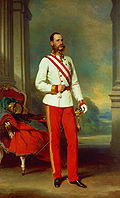 | Francis Joseph (František Josef I.) | 1848–1916 | Nephew of Ferdinand V. Also Austrian Emperor and King of Hungary. |
 | Charles III Karl I of Austria Charles I of Austria or Charles IV of Hungary was the last ruler of the Austro-Hungarian Empire. He was the last Emperor of Austria, the last King of Hungary, the last King of Bohemia and Croatia and the last King of Galicia and Lodomeria and the last monarch of the House of Habsburg-Lorraine... (Karel III.) | 1916–1918 | Grandnephew of Francis Joseph. Also Austrian Emperor and King of Hungary. Ruled briefly during First World War World War I World War I , which was predominantly called the World War or the Great War from its occurrence until 1939, and the First World War or World War I thereafter, was a major war centred in Europe that began on 28 July 1914 and lasted until 11 November 1918... and abdicated. |
See also
- Royal Consorts of BohemiaRoyal Consorts of BohemiaThis is a list of the royal consorts of the rulers of Bohemia.The first Duchess of Bohemia was St. Ludmila, while the first Queen of Bohemia was Świętosława of Poland. Some of them were not crowned.There was only one queen regnant in Czech history - Maria Theresa...

